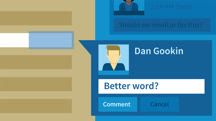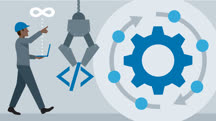Course catalog
Categories
Showing 8,021-8,040 of 9,135 items.
Teaching Techniques: Project-Based Learning
Explores the foundations of project-based learning, defining authentic learning and how project-based learning differs from "problem-based" learning.
Teaching with LinkedIn Learning
Learn how to teach with LinkedIn Learning. Discover how to create custom content, playlists, and resources; engage and empower learners; and ensure your content is accessible to all.
Teaching with Technology
Learn how to use technology to enhance course design, lesson planning, presentations, in-class activities, assessments, and student achievement and engagement.
Teaching Your Kids About Finance
Raise financially fit kids. Get practical tips for teaching kids the basics of how money is earned and spent, how to create saving goals, how to stick to a budget, and more.
Team Collaboration in G Suite
Learn how to fully leverage the collaboration features offered in G Suite (formerly Google Apps for Work), the popular cloud-based productivity platform.
Team Collaboration in Office 365 (Microsoft 365) (217767)
Microsoft 365, formerly known as Office 365, offers the latest Office apps and features for communication, file sharing, and project planning. The apps in Microsoft 365—Word, Excel, PowerPoint, Outlook, Teams, and more—are designed with collaboration in mind, yet many users aren’t leveraging all that these tools have to offer. In this course, Nick Brazzi offers tips for maximizing team productivity in Microsoft 365. Nick covers working with shared calendars in Outlook, connecting with your colleagues in Teams, and managing files that have been shared in Teams (as well as accessing those shared files in tools like SharePoint and Outlook). Plus, get tips for communicating more efficiently using Groups, using file libraries in SharePoint, sharing notes and files via OneDrive, creating shared tasks and projects in Planner, and more.
TeamCity 2017 Essential Training
Learn how to set up a continuous integration/continuous delivery workflow with TeamCity 2017 to build, test, and deploy code as a team.
Teamwork Foundations
Learn the qualities of effective teams and the role you, as a team member, play in creating a healthy, productive team.
Tech Career Skills: Communication for Developers (230585)
The work of developers doesn’t stop when code is committed. You need to help others understand the value of what you do—and why. This course examines the barriers between technological concepts and nontechnical audiences and proposes ways to overcome them. It identifies four major kinds: barriers of experience, motivation, perspective, and style. Instructor and communicator Tom Geller explains how to recognize these barriers and adapt your message to meet your audiences in the middle. He also examines specific opportunities to put your new skills into practice: with clients, vendors, team members, partners, conference audiences, and members of the public. The skills you learn in this course can benefit your career and your daily life. Discover how to overcome differences, strengthen your relationships, and promote your work by communicating in a way that everyone can understand.
Tech Career Skills: Developing Your Personal Brand
When your personal brand is well-known, you can unlock professional and personal opportunities. This course helps you identify your strengths, establish your presence, and more.
Tech Career Skills: Searching, Interviewing, and Landing a Job
Round out your resume. Learn the soft skills you need to be successful in hunting for a technical job, interviewing with stakeholders, and securing a role.
Tech Ethics: Avoiding Unintended Consequences
Embed ethics into your product development workflow. Explore examples of tech gone wrong—and how to avoid ethical issues in your own projects—in this lighthearted course.
Tech Recruiting Foundations: 1 Introduction (215642)
Tech is one of those rare places where demand for jobs is higher than the supply. With that in mind, how can recruiters and hiring managers get the best candidates for the job into the jobs they’re trying to fill? One way is by understanding the tech well enough to know exactly what you need. In this series of courses, instructor Ayub Shaikh goes over high-level IT concepts and breaks them into related, easy-to-remember groupings. This course introduces you to the series. Ayub defines critical terms and trends that you will need to understand, then explains how and why IT recruitment got started. He covers what IT is, shows you the basic structure of IT roles, and describes hardware and the specific skills that specific hardware may require.
Note: This course was created by Holistica Consulting. We are pleased to host this training in our library.
Note: This course was created by Holistica Consulting. We are pleased to host this training in our library.
Tech Recruiting Foundations: 2 Understanding Hardware and Operating Systems (219960)
Tech is one of those rare places where demand for jobs is higher than the supply. With that in mind, how can recruiters and hiring managers get the best candidates for the job into the jobs they’re trying to fill? One way is by understanding the tech well enough to know exactly what you need. In this series of courses, instructor Ayub Shaikh goes over high-level IT concepts and breaks them into related, easy-to-remember groupings. This course focuses specifically on hardware and operating systems. Ayub shows you a variety of hardware that may impact what skill set you need for an IT position, such as PCs, servers, mainframes, supercomputers, serverless API frameworks, and more. He explains operating system specifics, including what an operating system does, open and closed systems, and how Linux differs from other operating systems.
Note: This course was created by Holistica Consulting. We are pleased to host this training in our library.
Note: This course was created by Holistica Consulting. We are pleased to host this training in our library.
Tech Recruiting Foundations: 3 Recruiting Software Developers (219858)
Tech is one of those rare places where demand for jobs is higher than the supply. With that in mind, how can recruiters and hiring managers get the best candidates for the job into the jobs they’re trying to fill? One way is by understanding the tech well enough to know exactly what you need. In this series of courses, instructor Ayub Shaikh goes over high-level IT concepts and breaks them into related, easy-to-remember groupings. This course focuses specifically on recruiting software developers. Ayub explains what makes up application software and what developers, engineers, and other titles actually do. He also covers differences between recruiting front-end developers and recruiting back-end developers.
Note: This course was created by Holistica Consulting. We are pleased to host this training in our library.
Note: This course was created by Holistica Consulting. We are pleased to host this training in our library.
Tech Recruiting Foundations: 4 Recruiting for the IT Department (219875)
Tech is one of those rare places where demand for jobs is higher than the supply. With that in mind, how can recruiters and hiring managers get the best candidates for the job into the jobs they’re trying to fill? One way is by understanding the tech well enough to know exactly what you need. In this series of courses, instructor Ayub Shaikh goes over high-level IT concepts and breaks them into related, easy-to-remember groupings. This course focuses on how you can recruit successfully for an IT department. Ayub introduces you to the roles that exist in the modern IT department, as well as internal and outsourced needs. He walks you through finding cloud-capable candidates and exploring the different silos into which IT roles are often grouped. Ayub concludes this course with a discussion of some caveats and considerations that you may encounter for networking and ops roles.
Note: This course was created by Holistica Consulting. We are pleased to host this training in our library.
Note: This course was created by Holistica Consulting. We are pleased to host this training in our library.
Tech Recruiting Foundations: 5 Waterfall, Agile, and DevOps for Recruiters (219841)
Tech is one of those rare places where demand for jobs is higher than the supply. With that in mind, how can recruiters and hiring managers get the best candidates for the job into the jobs they’re trying to fill? One way is by understanding the tech well enough to know exactly what you need. In this series of courses, instructor Ayub Shaikh goes over high-level IT concepts and breaks them into related, easy-to-remember groupings. This course focuses specifically on waterfall, agile, and DevOps. First, Ayub explains the waterfall model, its strengths, its drawbacks, and how those drawbacks led to the development of the agile model. Next, he introduces you to the agile manifesto, key principles of agile development, and how you can identify and recruit agile candidates. Ayub concludes with a discussion of devops, including how it combines two separate silos of IT skills and how you can find and recruit devops candidates.
Note: This course was created by Holistica Consulting. We are pleased to host this training in our library.
Note: This course was created by Holistica Consulting. We are pleased to host this training in our library.
Tech Sense
Find out what the latest tech trends have to offer you. Explore the benefits and business value of emerging technologies such as microservices, machine learning, and minification.
Tech Simplified: Everyday Tech Questions
Get simple answers to everyday tech questions. Find out if Wi-Fi is trustworthy, why your computer is slow, what you should do about suspicious email, and more.
Tech Soft Skills: Interviewing Developers
Looking to add a new developer to your team? Learn how to prepare for and conduct interviews to accurately assess a candidate's technical aptitude and overall fit.



















